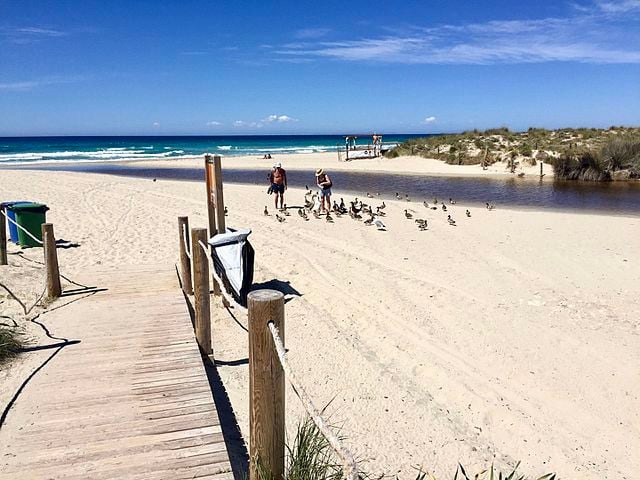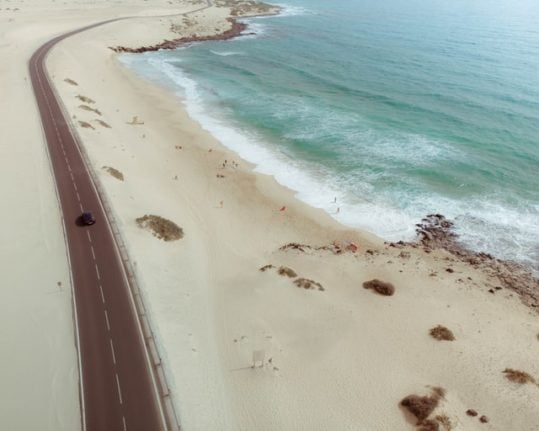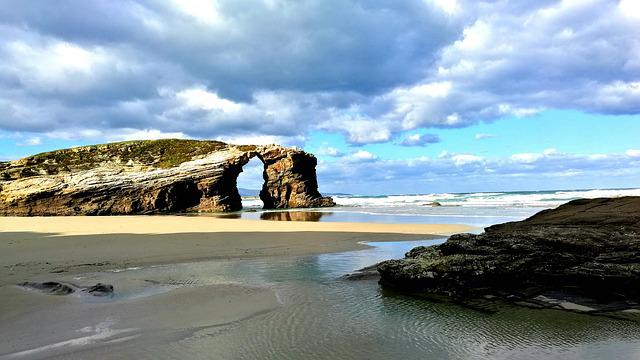This year, 2022, Spain has been awarded a total number of 621 Blue Flag beaches, the most in the world, beating the likes of Greece, Turkey, France and Italy.
Blue Flags are awarded to those beaches that meet demands on issues such as hygiene, sanitary conditions, safety, accessibility and the provision of lifeguards.
Spain is once again the top country worldwide for Blue Flags awarded for their excellent water quality and environmental standards by the Foundation for Environmental Education (FEE).
This year, six more Blue Flags have been awarded than in 2021.
Click here to zoom into the Blue Flag interactive map and see where all the beaches are located and continue reading below to find out which region has the most and which ones they are.
READ ALSO: Ten incredible natural swimming spots in Spain
Andalusia
It’s not surprising that the southern region of Andalusia is home to the second-highest number of Blue Flag beaches in Spain with 122 in total. The most are to be found in Almería, closely followed by Málaga and then Cádiz.
Almería: Censo, El Carboncillo, San Nicolás, Sirena Loca, Almería, San Miguel de Cabo de Gata, Balanegra, El Ancón, El Corral, Las Marinicas, Playa de Villaricos, Pozo del Esparto, Balerma, Levante Almerimar, Poniente Almerimar, San Miguel, El Cantal, El Descargador, Lance Nuevo, Marina de la Torre, Piedra Villazar, Venta del Bancal Ventanicas, Aguamarga, San José, Calipso, Los Nardos, Mar Rabiosa Mar Serena, Aguadulce, La Bajadilla, Las Salinas, Romanillas Urbanización, Playa Serena Urbanización, Roquetas and El Playazo.
Cádiz: Getares, Zahara de los Atunes, La Cortadura-Poniente, La Victoria, Santa María del Mar, La Barrosa, Sancti Petri, Camarón-La Laguna, Cruz del Mar-Canteras, Micaela, Regla, Tres Piedras-La Ballena, El Roche, La Fontanilla, Los Bateles, Fuentebravía, La Puntilla Santa Catalina, Valdelagrana, Galeones, La Ballena, La Costilla, Punta Candor, Puntalillo Rompidillo-Chorrillo, Camposoto-El Castillo, Alcaidesa- El Faro, Cala Sardina and El Palmar
Córdoba: La Breña
Granada: La Herradura, Marina del Este, Puerta del Mar, San Cristóbal Velilla, Sotillo-Castell, Calahonda, Playa Granada, La Guardia, Del Cañon-La Pelá (Azucenas), Torrenueva
Huelva: Isla Canela, Los Haraganes, Punta del Moral, Caño de la Culata, San Miguel, Santa Pura, La Casita Azul, Islantilla, Del Parador (Castilla), El Albergue
Málaga: Algarrobo Costa, Ardales, Fuente de la Salud, Torrebermeja-Santa Ana, Ancha, Boliches-Gaviotas Carvajal, Castillo, Fuengirola, Caleta, El Dedo, El Palo, Malagueta, Misericoria, Pedregalejo, San Andrés, Sabinillas, Adelfas-Alicate Casablanca, El Cable, El Faro, Puerto Banús-Levante, San Pedro de Alcántara (Guadalmina), Venus-Bajadilla, Calahonda I (Royal Beach – La Luna) El Bombo, La Cala, Burriana, Maro, Torrecilla, Los Álamos, El Morche, Ferrara, Benajarafe, La Caleta (Paseo) and Torre del Mar.

Asturias
The region of Asturias has been awarded a modest 14 Blue Flag beaches, flanked by the Cantabrian Sea.
Arnao, Salinas, Santa María del Mar, Arnao, Peñarronda, Concha de Artedo, San Pedro Bocamar, Aguilar, Frejulfe, Anguileiro,Cadavedo, Otur and La Ñora Rodiles.

Balearic Islands
The ever-popular Balearic Islands boast a total of 30 Blue Flag beaches, with the island of Mallorca home to the most. Formentera, the smallest of the Balearic Islands, which is recognised for its pristine beaches, does not count any Blue Flags on them because it is so small and didn’t apply to be considered.
Ibiza: Cala Sant Vicent, Cala Llenya, Es Canar and Es Figueral
Mallorca: Cala Ferrera, Cala Marçal, Cala Sa Nau, Porto Colom (Platja S’ Arenal), Muro, Cala Estància, Cala Major, Playa de Palma (El Arenal), Cala Barques, Cala Molins, Cala Millor (Cala Nau), Sa Coma, Can Picafort, Son Bauló, Son Serra, Cala Gran, Cala Llombards, Cala Mondragó (Sa Font de n’Alís), Cala Santanyí S’Amarador, Es Dolç (Es Port), Cala Millor and Es Ribell.
Menorca: Cala en Porter, Son Bou and Cala Galdana.

Canary Islands
It’s not surprising that Spain’s tropical-esque Canary Islands have been awarded a total of 54 Blue Flag beaches, spread across seven of its islands. Tenerife, Fuerteventura and Gran Canaria all have an equal 12 each.
Fuerteventura: Castillo, Corralejo Viejo, Grandes Playas, La Concha, Butihondo, Costa Calma, El Matorral, Morro Jable, Blanca, Los Pozos, Puerto Lajas and Gran Tarajal.
Gran Canaria: Las Nieves, Arinaga, El Puertillo, Los Charcones, Sardina, El Burrero, Las Canteras, El Inglés, Hoya del Pozo, La Garita, Melenara and Salinetas.
Lanzarote: El Reducto, Las Cucharas, Grande (Blanca), Matagorda, Pila de la Barrilla, Pocillos and Blanca.
La Gomera: Santiago, La Cueva and San Sebastián de la Gomera.
El Hierro: La Restinga and Timijiraque.
La Palma: Bajamar, Los Cancajos, Charco Verde, Puerto Naos, Santa Cruz de la Palma and El Puerto de Tazacorte.
Tenerife: El Duque, Torviscas, El Camisón, Las Vistas, El Muelle, Piscinas Naturales de El Caletón, Playa de la Jaquita, San Marcos, Socorro, Piscinas Naturales de Bajamar, Piscina Natural del Arenisco and La Arena (Mesa del Mar).

Cantabria
Spain’s northern area known as Green Spain, may not have as many Blue Flag beaches as the southern regions, but Cantabria has still been awarded 11.
El Sable de Quejo, La Arena, Oriñón, Ostende, Comillas, Ris, Trengandín, Sable de Merón, Berria, El Sable de Tagle and Los Locos.

READ ALSO: 12 pictures that show the true beauty of northern Spain’s beaches
Catalonia
With one whole edge bordering the Mediterranean and its picturesque Costa Brava and Costa Daurada coastlines, it’s fitting that Catalonia is home to 94 Blue Flag beaches. Tarragona and the Costa Daurada boast the most.
Barcelona: Cristall, Pescadors, Bogatell, Mar Bella, Nova Mar Bella, Sant Sebastià, Dels Tres Micos, Garbí, Canet, Del Baixador, Lluminetes, Llarga, El Masnou, Gavà Mar, Malgrat Centre, L’Astillero, Pescadors, La Riera, Les Barques, Aiguadolç, Balmins, Garraf, L’Estanyol, La Barra, La Ribera, Les Botigues, Sant Sebastiá, Terramar, D´Adarró, Ibersol, Ribes Roges and Sant Gervasi.
Girona: Blanes, S’Abanell, Sant Francesc (Cala Bona), Cala Cristus-Ses Torretes, Es Monestrí, Sant Antoni, Torre Valentina, Cala Rovira, Platja Gran, Sa Conca, Del Port, Grifeu, Cala Canyelles, Lloret, Sa Boadella, Santa Cristina, Canadell, Llafranc, Tamariu, La Fosca, Port de la Selva, Sant Feliu, Sant Pol, Cala Montgó, Gran de Tossa and La Mar Menuda.
Tarragona: Altafulla, Calafell, L’Estany Mas Mel, Segur de Calafell, Cavet, La Llosa Prat d’en Forés- El Regueral, Vilafortuny, Cunit Llevant, Cunit Ponent, Costa Daurada, Llarga, Capellans, Llevant, L’Arrabassada, La Móra, Savinosa, Tamarit, Barri Marítim, Els Muntanyans, La Paella, L’Almadrava, L’Arenal, La Punta del riu, El Torn, La Pineda, Les Cases d’Alcanar-El Marjal, Riumar, Calafató, Cala Forn, L’Alguer, Sant Jordi d’Alfama, Cap Roig, Les Avellanes, Les Delícies and Parc de Garbí.

Valencia
Spain’s eastern region of Valencia takes the top spot for Blue Flag beaches with a whopping 139. Over half of these are in the Alicante province.
Alicante: L’Albufereta, Postiguet, Saladar-Urbanova, Sant Joan Tabarca, Cap Blanc, La Roda, L’Espigó, Llevant, Mal Pas, Cala Baladrar, Cala Fustera, Cantal Roig, La Fossa, L’Arenal-Bol, Les Bovetes, Les Deveses, Les Marines, Marineta Cassiana, Molins, Punta del Raset, Carrer de la Mar, Mutxavista, Cala del Moraig, Arenals del Sol-Sur, Carabassí, L’Altet, La Marina, Les Pesqueres-El Rebollo, Centre, El Moncaio, La Roqueta, Dels Vivers, Racó de L’Albir, Aguamarina, Barranco, Rubio, Cabo Roig -La Caleta, Cala Capitán, Cala Cerrada, Cala Estaca, Cala Mosca, Campoamor-La Glea, La Zenia- Cala Bosque, Mil Palmeras, Punta Prima, Conde Higuericas, Jesuitas, Mil Palmeras, Puerto Rocamar, Calas del Este, Calas Santiago Bernabéu, La Ermita, Llevant, Tamarit, Varador, El Portet, La Ampolla, Les Platgetes, Cabo Cervera, Cala de las Piteras, El Cura, Los Locos, Los Náufragos, Torrelamata-Sur, Bon Nou, Ciutat (Centro), La Caleta, Paradís, Varadero, L´Arenal, Granadella and La Grava.
Castellón: El Carregador, El Moro, La Romana, Manyetes, Benafeli, La Caracola, Morrongo, Dels Terrers, Heliópolis, L´Almadrava, Torre de Sant Vicent, Voramar, El Grao-Malvarrosa, L´Arenal, Gurugú, Pinar, Grao, L’Estanyol, Masbó, Pedra Roja, Marines, La Conxa, Les Amplaries, Morro de Gos, Plagetes de Bellver, Peñíscola Nord, Torreblanca Nord, Fora Forat, Forti, El Cerezo and Les Cases.
Valencia: Bellreguard, Racó de la Mar, Cap Blanc, El Dossel, El Far, Escollera, Los Olivos, Marenyet-L’illa, Racó, Sant Antoni, Daimús, Auir, Nord, Norte, Miramar, L’ Aigua Morta, L’Aigua Blanca, Pau-Pi ,Terranova-Burguera, Piles, Puçol, Corint, L’Almardá, Port de Sagunt, La Goleta, Tavernes de la Valldigna, Cabanyal, El Saler, L’ Arbre del Gos, La Devesa, La Garrofera, Malva-Rosa, Recatí-Perellonet and Xeraco.

Extremadura
Extremadura may not have a coastline, but that hasn’t stopped it from being awarded several Blue Flag river and lake beaches. It’s home to a total of 8.
Alange, Campanario, Los Calicantos, Isla del Zújar, La Dehesa, El Espolón-Peloche, Playa dulce de Orellana and Talarrubias-Puerto Peña.
Galicia
Bordering the Atlantic Ocean, Galicia’s wild windswept coastline has been awarded a total of 112 Blue Flag beaches. The province of Pontevedra is home to the most, while A Coruña follows close behind.
A Coruña: As Lapas, Orzán-Matadero, Oza, Riazor, San Amaro, Caión, A Hucha, A Salsa (Repibelo), Barrañán, Combouzas, O Reiro, Porto de Suevos, Sabón, Valcobo, Lago de As Pontes, Gandarío, Arou, Pedra do Sal, Razo, Saíñas, Ézaro, A Fragata-O Pereixal, Doniños, Esmelle, San Xurxo, Laxe, Perbes-Andahío, Bastiagueiro, Espiñeiro, Mera, Naval, Santa Cristina, A Ermida, Balarés, O Osmo and Coroso.
Lugo: A Pasada, Coto, Fontela Valea, A Marosa, O Portelo, Ril, O Torno, A Rapadoira, Areoura, As Polas, Llas, Peizás, Abrela, Xilloi, As Catedrais, Os Castros-Illas, Area and Esteiro.
Pontevedra: Area Grande, O Muíño, Area da Secada, Bao (Camaxe), Barbeira, Concheira, Frades, Ladeira, Ribeira, Santa Marta, Area de Bon, Banda do Rio, Lagos, Lapamán, Portomaior, Areabrava, Areamilla, Liméns, Menduiña, Nerga, Aguete, Loira, Mogor, Portocelo, Santo de Mar – A Coviña, O Con, Cabeceira, Playa fluvial A Calzada, A Lapa, Agra Areas, Areas Gordas, Baltar, Bascuas, Canelas, Caneliñas, Foxos, Major, Montalvo, Nosa Señora da Lanzada, O Espiñeiro-A Lanzada, Panadeira, Paxariñas, Pragueira, Silgar, A Punta, Argazada, Canido, Carril, Fontaiña, Fortiñón, O Vao, Rodas (Islas Cíes), Samil, Santa Baia, Tombo do Gato, Campanario and Compostela.

Madrid
Even landlocked Madrid is home to one Blue Flag beach, the sandy surrounds of the banks of the San Martín de Valdeiglesias reservoir. This is now the fifth year, Virgen de la Nueva has had Blue Flag status.
Virgen de la Nueva
| Banner ad |
Murcia
The small region of Murcia may not have anywhere near the number of Blue Flag beaches as its neighbour Valencia, but still has a respectable 27.
Calarreona, La Carolina, La Casica, Verde, La Colonia, La Higuerica, Las Delicias, Levante, Matalentisco, Poniente, Cala Cortina, Isla Plana, La Azohía-El Cuartel, La Chapineta, Levante-Cabo de Palos, San Ginés, Calnegre, Alamillo, Bahía Del Mojón, Del Puerto, Grande-Castellar, Nares, Rihuete, Banco del Tabal-Calnegre, Ensenada del Esparto, Pedrucho and El Mojón.
Basque Country
Bordering the Bay of Biscay, the Basque Country’s beaches may be known more for surfing than for relaxing and swimming, but three of these have Blue Flag status.
Landa, Moskurio (Garaio Norte) and Salurriaga (Garaio Sur).



 Please whitelist us to continue reading.
Please whitelist us to continue reading.
Member comments